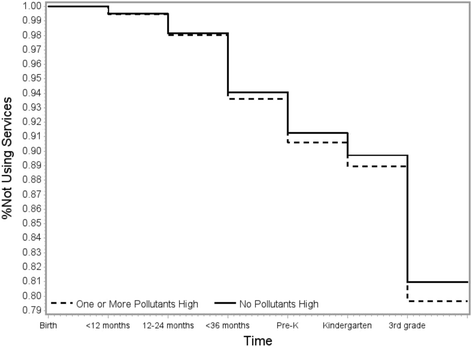Early-life exposure to air pollution and greater use of academic support services in childhood: a population-based cohort study of urban children
- PMID: 28100255
- PMCID: PMC5241986
- DOI: 10.1186/s12940-017-0210-z
Early-life exposure to air pollution and greater use of academic support services in childhood: a population-based cohort study of urban children
Abstract
Background: There is a growing literature showing associations between prenatal and early-life exposure to air pollution and children's neurodevelopment. However, it is unclear if decrements in neurodevelopment observed in epidemiologic research translate into observable functional outcomes in the broader pediatric population. The objective of this study was to examine the association between early-life exposures to common urban air toxics and the use of academic support services, such as early intervention and special education within a population-based cohort of urban children.
Methods: Data for 201,559 children born between 1994 and 1998 in New York City were obtained through administrative data linkages between birth, early intervention and educational records. Use of academic support services was ascertained from birth through attendance in 3rd grade. Census tract at birth was used to assign estimates of annual average ambient concentrations of benzene, toluene, ethylbenzene and xylenes (BTEX) using the 1996 National Air Toxics Assessment. Discrete-time hazard models were fit to the data and adjusted for confounders including maternal, childhood and neighborhood factors.
Results: Children with higher exposures to BTEX compounds were more likely to receive academic support services later in childhood. For example, the adjusted hazard ratio comparing children exposed to the highest decile of benzene to those with lower exposure was 1.09 (95% confidence interval 1.05, 1.13). Results were consistent across individual BTEX compounds, for exposure metrics which summarized exposure to all four BTEX pollutants and for multiple sensitivity analyses.
Conclusions: These findings suggest urban air pollution may affect children's neurodevelopment and educational trajectories. They also demonstrate the use of public health data systems to advance children's environmental health research.
Keywords: Benzene; Early intervention; School outcomes; Special education; Traffic-related air pollution.
Figures


Similar articles
-
Personal and ambient exposures to air toxics in Camden, New Jersey.Res Rep Health Eff Inst. 2011 Aug;(160):3-127; discussion 129-51. Res Rep Health Eff Inst. 2011. PMID: 22097188
-
Combined association of BTEX and material hardship on ADHD-suggestive behaviours among a nationally representative sample of US children.Paediatr Perinat Epidemiol. 2019 Nov;33(6):482-489. doi: 10.1111/ppe.12594. Epub 2019 Oct 27. Paediatr Perinat Epidemiol. 2019. PMID: 31657027 Free PMC article.
-
Association between GIS-based exposure to urban air pollution during pregnancy and birth weight in the INMA Sabadell Cohort.Environ Health Perspect. 2009 Aug;117(8):1322-7. doi: 10.1289/ehp.0800256. Epub 2009 Apr 13. Environ Health Perspect. 2009. PMID: 19672415 Free PMC article.
-
[General population exposure to volatile aromatic hydrocarbons].Arh Hig Rada Toksikol. 2004 Nov;55(4):291-300. Arh Hig Rada Toksikol. 2004. PMID: 15584556 Review. Croatian.
-
A review and meta-analysis of outdoor air pollution and risk of childhood leukemia.J Environ Sci Health C Environ Carcinog Ecotoxicol Rev. 2015;33(1):36-66. doi: 10.1080/10590501.2015.1002999. J Environ Sci Health C Environ Carcinog Ecotoxicol Rev. 2015. PMID: 25803195 Free PMC article. Review.
Cited by
-
Prenatal exposure to polycyclic aromatic hydrocarbons, reduced hippocampal subfield volumes, and word reading.Dev Cogn Neurosci. 2025 Apr;72:101508. doi: 10.1016/j.dcn.2025.101508. Epub 2025 Jan 11. Dev Cogn Neurosci. 2025. PMID: 39827783 Free PMC article.
-
Environmental Toxicant Exposure and Depressive Symptoms.JAMA Netw Open. 2024 Jul 1;7(7):e2420259. doi: 10.1001/jamanetworkopen.2024.20259. JAMA Netw Open. 2024. PMID: 38958973 Free PMC article.
-
Prenatal air pollution exposure and neurodevelopment: A review and blueprint for a harmonized approach within ECHO.Environ Res. 2021 May;196:110320. doi: 10.1016/j.envres.2020.110320. Epub 2020 Oct 22. Environ Res. 2021. PMID: 33098817 Free PMC article. Review.
-
Quantifying Urban Spatial Variations of Anthropogenic VOC Concentrations and Source Contributions with a Mobile Sampling Platform.Int J Environ Res Public Health. 2019 May 10;16(9):1632. doi: 10.3390/ijerph16091632. Int J Environ Res Public Health. 2019. PMID: 31083299 Free PMC article.
-
Prenatal exposure to air pollution is associated with childhood inhibitory control and adolescent academic achievement.Environ Res. 2021 Nov;202:111570. doi: 10.1016/j.envres.2021.111570. Epub 2021 Jun 25. Environ Res. 2021. PMID: 34181922 Free PMC article.
References
-
- Harris MH, Gold DR, Rifas-Shiman SL, Melly SJ, Zanobetti A, Coull BA, Schwartz JD, Gryparis A, Kloog I, Koutrakis P, et al. Prenatal and childhood traffic-related pollution exposure and childhood cognition in the project viva cohort (Massachusetts, USA) Environ Health Perspect. 2015;123(10):1072–1078. doi: 10.1289/ehp.1408803. - DOI - PMC - PubMed
-
- Kim E, Park H, Hong YC, Ha M, Kim Y, Kim BN, Kim Y, Roh YM, Lee BE, Ryu JM, et al. Prenatal exposure to PM10 and NO2 and children’s neurodevelopment from birth to 24 months of age: mothers and children’s environmental health (MOCEH) study. Sci Total Environ. 2014;481:439–445. doi: 10.1016/j.scitotenv.2014.01.107. - DOI - PubMed
-
- Porta D, Narduzzi S, Badaloni C, Bucci S, Cesaroni G, Colelli V, Davoli M, Sunyer J, Zirro E, Schwartz J, et al. Air pollution and cognitive development at age 7 in a prospective Italian birth cohort. Epidemiology. 2016;27(2):228–236. - PubMed
MeSH terms
Substances
Grants and funding
LinkOut - more resources
Full Text Sources
Other Literature Sources
Medical
Miscellaneous

